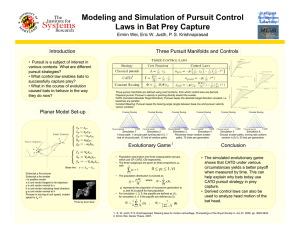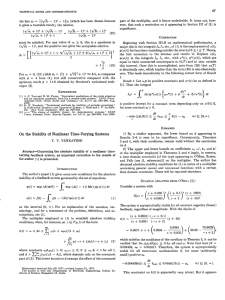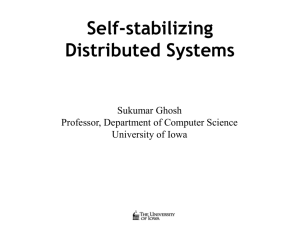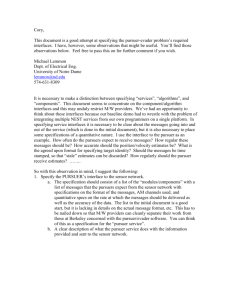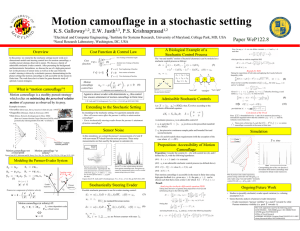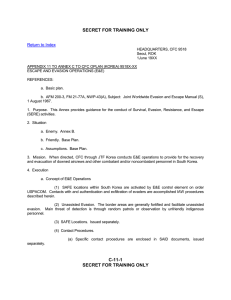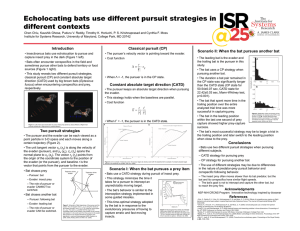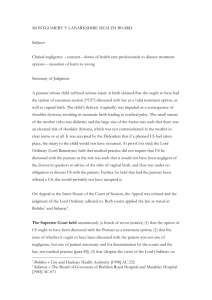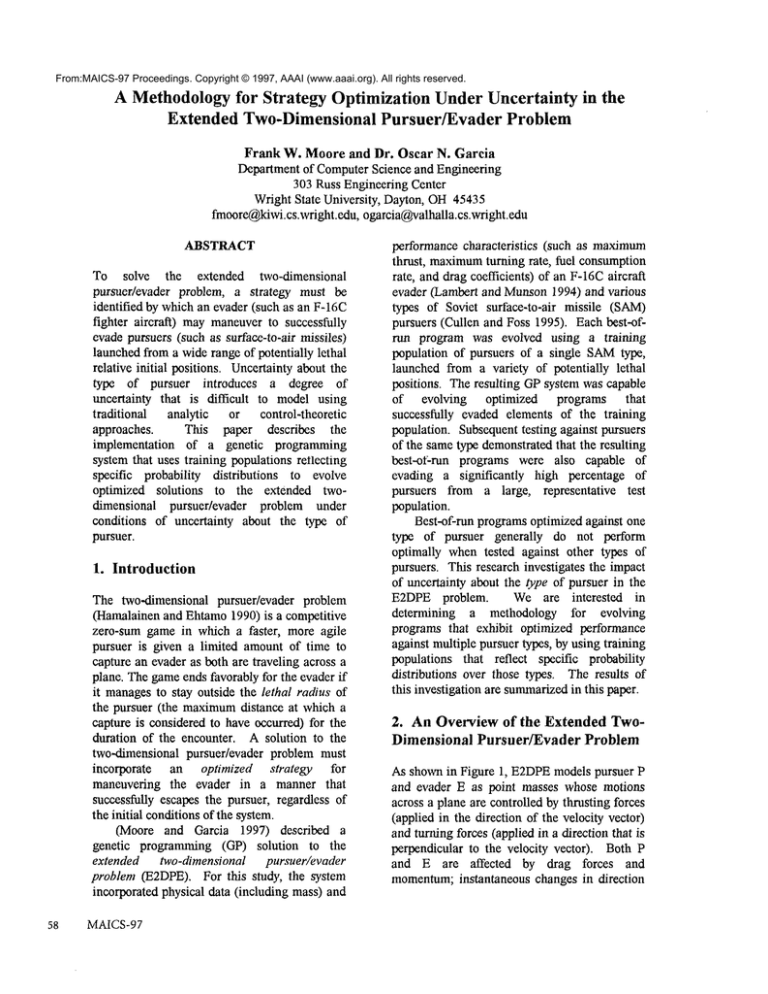
From:MAICS-97 Proceedings. Copyright © 1997, AAAI (www.aaai.org). All rights reserved.
A Methodology for Strategy Optimization Under Uncertainty in the
Extended Two-Dimensional Pursuer/Evader Problem
Frank W. Moore and Dr. Oscar N. Garcia
Department of ComputerScience and Engineering
303 Russ Engineering Center
Wright State University, Dayton, OH45435
fmoore@,kiwi.cs.wright,edu, ogarcia@valhalla.cs.wright.edu
ABSTRACT
To solve the extended two-dimensional
pursuer/evader problem, a strategy must be
identified by which an evader (such as an F-16C
fighter aircraft) maymaneuverto successfully
evade pursuers (such as surface-to-air missiles)
launched from a wide range of potentially lethal
relative initial positions. Uncertainty about the
type of pursuer introduces
a degree of
uncertainty that is difficult to model using
traditional
analytic
or control-theoretic
approaches.
This paper describes the
implementation of a genetic programming
system that uses training populations reflecting
specific probability distributions to evolve
optimized solutions to the extended twodimensional pursuer/evader
problem under
conditions of uncertainty about the type of
pursuer.
1. Introduction
The two-dimensional pursuer/evader problem
(Hamalainen and Ehtamo1990) is a competitive
zero-sum game in which a faster, more agile
pursuer is given a limited amount of time to
capture an evader as both are traveling across a
plane. The gameends favorably for the evader if
it managesto stay outside the lethal radius of
the pursuer (the maximumdistance at which
capture is considered to have occurred) for the
duration of the encounter. A solution to the
two-dimensional pursuer/evader problem must
incorporate
an optimized
strategy
for
maneuvering the evader in a manner that
successfuUy escapes the pursuer, regardless of
the initial conditions of the system.
(Moore and Garcia 1997) described
genetic programming (GP) solution to the
extended two-dimensional
pursuer~evader
problem (E2DPE). For this study, the system
incorporated physical data (including mass) and
58
MAICS-97
performance characteristics (such as maximum
thrust, maximum
turning rate, fuel consumption
rate, and drag coefficients) of an F-16Caircraft
evader (Lambert and Munson1994) and various
types of Soviet surface-to-air missile (SAM)
pursuers (Cullen and Foss 1995). Each best-ofrun program was evolved using a training
population of pursuers of a single SAMtype,
launched from a variety of potentially lethal
positions. The resulting GPsystem was capable
of evolving
optimized
programs that
successfully evaded elements of the training
population. Subsequenttesting against pursuers
of the same type demonstratedthat the resulting
best--or-run programs were also capable of
evading a siL’nificantly
high percentage of
pursuers from a large, representative test
population.
Best-of-run programs optimized against one
type of pursuer generally do not perform
optimally when tested against other types of
pursuers. This research investigates the impact
of uncertainty about the type of pursuer in the
E2DPE problem.
We are interested
in
determining a methodology for evolving
programs that exhibit optimized performance
against multiple pursuer types, by using training
populations that reflect specific probability
distributions over those types. The results of
this investigation are summarizedin this paper.
2. AnOverviewof the ExtendedTwoDimensionalPursuer/EvaderProblem
As shown in Figure 1, E2DPEmodels pursuer P
and evader E as point masses whose motions
across a plane are controlled by thrusting forces
(applied in the direction of the velocity vector)
and turning forces (applied in a direction that is
perpendicular to the velocity vector). Both
and E are affected
by drag forces and
momentum;instantaneous changes in direction
Y
X
Predicted
Impact
Point
"~"............................
>X
[PURSUERI
Figure 1. The Extended Two-DimensionalPursuer/Evader Problem (Initial
are not possible. Since acceleration (a), force
(F), and mass (m) are related by the equation
F/m, the acceleration of P or E depends on its
current mass, as well as the magnitude of the
applied thrusting and turning forces. The
effects of these forces depend on the current
state (the position, velocity, and acceleration
vectors) of P or E. The maximum
distance over
which P pursues E depends on the type of
pursuer. P captures E as soon as the distance
between them becomes less than a pursuerspecificlethal radius.
Prior to the start of the encounter, the
pursuer uses the initial state (position, velocity,
and acceleration) of the evader to predict an
intercept point. The pursuer is then launched at
maximum
thrust in the direction of the intercept
point. If the evader fails to maneuver, the
pursuer captures the evader at (or very close to)
the intercept point. If the evader maneuvers,the
pursuer relies upon the highly effective
proportional navigation technique (Ball 1985)
to pursue the evader. Proportional navigation
causes the pursuer to accelerate in the direction
perpendicular to the line-of-sight
from the
pursuer to the evader; the magnitude of this
acceleration is calculated by the equation
no = N’ Vc (dL/dt)
where N’ is a unitless designer-chosen gain
knownas the effective navigation ratio, and Vc
is the pursuer-evader dosing velocity vector (the
Conditions).
negative rate of change of the distance from the
pursuer to the evader). The time derivative of
the line-of-sight angle ~, is knownas the line-ofsight rate. For practical guidance systems,
optimal values for N’ range between 3 and 5
(Ramoand Pucket 1959); for this study, each
pursuer used an effective navigation ratio N’ =
4.
The evader maneuversby executing specific
combinationsof tb.rusting and turning forces in
specific sequences. The optimal strategy for the
evader is to maneuver in a manner that
maximizes the likelihood
of evading the
pursuer, regardless of the initial state of the
evader and the relative launch position of the
pursuer (Zarchan 1990). Note that by rotating
the reference coordinate system at the launch
site of the pursuer, the initial pursuer/evader
line-of-sight
angle Lo may be considered
constant for all pursuer/evader pairs. For this
reason, the only variables necessary to describe
the initial configuration of each confrontation
are the line-of-sight distance betweenthe evader
and the pursuer, and the velocity vector of the
evader at the time the pursuer is launched.
For each pursuer type, the minimumand
maximum
effective range of the pursuer defines
the range of possible initial line-of-sight
distances. The aggregate fitness of a specific
program reflects its fitness when executed
against each of these initial pursuer positions.
The optimal evasion program considers the
current state of the evader and pursuer, and
Moore
59
outputs commandsthat assert thrusting and
turning forces at appropriate momentsin order
to accomplish maneuvers that optimize evader
survivability:
THRUST
-- Set the thrusting force to
the specified percentageof the
evader’s maximumthn~.
TURN
- Apply a turning force equal to
the specified percentageof the
evader’s maximum
turning force,
in a direction perpendicularto the
evader’s current velocity vector;
negativevalues indicate a left turn,
while positive values indicate a
fight turn,
3. Prior Research
(Moore and Garcia 1997) described a genetic
programming (Koza 1992) solution to the
E2DPEproblem. During each generation of the
genetic programmingapproach, each memberof
a population of programs for maneuvering the
evader was trained against each memberof a
training population of pursuers. Each genetic
programming run optimized maneuvers against
a single type of pursuer.
Proportional
navigation was used by all pursuers. The
pursuer and evader had complete knowledge of
each other’s current state (relative position,
velocity, and acceleration). A fitness function
was used to qualitatively evaluate each evasion
program during a simulated encounter; the
aggregate fitness of a particular program
reflected its fitness whenindependently trained
against all of the pursuers in the training
population. Fitness-proportionate reproduction,
together with crossover, was used to create each
new generation. Each run was terminated after
a fixed numberof generations.
A tableau for the E2DPEproblem is shown
Figure 2. Cartesian coordinates were used to
represent componentsof position, velocity, and
acceleration for both the evader and the pursuer.
This simple set of terminals proved to be
sufficient to allow the genetic programming
systemto convergeto a solution of this problem.
This two-dimensional pursuer/evader problem
fixes the origin of the coordinate system(x = 0,
y = 0) at the position of the pursuer. PXand PY
thus continually
designate the relative
displacementfrom the pursuer to the evader.
6O MAICS-97
For each of the functions used by this GP
system, an "argument" may consist of any
syntactically valid composition of functions,
variables, and constants that returns a floatingpoint value in the range [-1.0 ... +1.0].
Function ifPX is a two-argument selection
function: if the x-displacement of the evader
relative to the position of the pursuer is
negative, then the first argumentis evaluated;
otherwise, the second argument is evaluated.
Function iff’Y is a two-argument selection
function defined in a similar mannerfor the ydisplacement of the evader. Function ifDistance
is a three-argument selection function: if the
current distance between the pursuer and evader
is less than the percentage of the maximum
pursuit distance specified by the absolute value
of the first argument, then the second argument
is evaluated; otherwise the third argument is
evaluated. Functions itPX, itPY, and itDistance
each return the value of the evaluated argument.
Functions setThrust and hardTurn are singleargument functions. Function setThrust causes
the thrust output of the evader to be set to the
percentage of its maximum
thrust specified by
its argument; for example, setThrust (0.9) will
set evader thrust to 90% of its maximum
possible value. SetThrust ignores the sign of its
argument; thrust always acts in the direction of
the current evader velocity vector. Function
hardTum causes the evader to execute a turn
whose g-force equals the percentage of the
maximum allowable turning force of the
evader/pilot system specified by its argument;
for example, if the maximum
turning force is 4
gravities (g’s), then hardTurn(0.5) will cause
the evader to execute a 2g turn in a direction
which is perpendicular and to the right of the
current evader velocity vector; the function call
hardTurn(-0.5) wouldresult in a 2g evader turn
to the left. Both setThrust and hardTum are
assumedto act instantaneously, and both return
the value of their input argument.
The following example illustrates
a
programthat might be automatically created by
the GPsystemused for this project:
(iff)istance 0.1
(hardTurn (setThrust -0.75))
(setThrust (hardTurn 0.9)))
This programwill cause the evader to thrust at
90%of its maximumthrust value, and turn to
the right at 90%of its maximum
turning rate,
Objective:
Determinean optimized evasion strategy for the extended
two-dimensional pursuer/evader problem.
TerminalSet: "
PX, the displacementin the x-direction from the pursuer to the evader.
PY, the displacementin the y-direction from the pursuer to the evader.
R, the ephemeral randomfloating-point constant ranging from -1.0 to 1.0.
FunctionSet:
ilPX
itPY
itDistance
setThrust
hardTurn
Fitness Cases:
Numerousfitness cases which differ according to the distance from the
pursuer to the evader at the start of the encounter, as well as the acute
angle betweenthe initial velocity vector of the evader and the line-of-sight
vector from evader to pursuer.
RawFitness:
The numberof times the distance betweenthe pursuer and evader is less
than or equal to the lethal envelopeof the pursuer.
Standardized Fitness: Sameas RawFitness for this problem.
Hits:
Thenumberof fitness cases that result in capture of the evader prior to the
maximum
pursuit time of the pursuer. (The encounter is also terminated if
the distance betweenthe evader and the pursuer exceeds a pursuer-specific
value, at whichtime the pursuer is considered to have missed the evader.)
Wrapper:
N/A
Parameters:
Population Size M= 100, MaximumNumberof Generations G = 21.
Success Predicate:
None.
Figure 2. A Tableau for the Extended Two-Dimensional Pursuer/Evader Problem
until the pursuer has closed to within 10%of the
maximum
pursuit range; it will then cause the
evader to turn left at 75% of its maximum
turning rate, and set thrust to 75% of its
maximumthrust value.
Fitness cases were identified by two values.
The first value, denotedJ, identifies the initial
line-of-sight distance from the pursuer to the
evader. If Dm~and Dm~denote the minimum
and maximum
effective launch distances for the
pursuer, then the initial line-of-sight distance do
maybe calculated as follows:
do = Dmi~+ (J * (Dmax- Dram))
D~ and Dm~xdepend upon the type of pursuer.
The second value, denoted K, identifies the
angle that the initial velocity vector of the
incoming evader makes with the line-of-sight
from the evader to the pursuer. Let ®o denote
this angle. If Gmmand Gm~ denote the
minimumand maximuminitial value of G, then
Go maybe calculated in the following manner:
Go= G~+ (K * (G~=<- G "m~))
To maintain the relative geometryillustrated in
Figure 1 for the pursuer/evader problems
addressed by this research,
G~ and Gm~
described a range of values between 10 and 80
degrees. For this study, the magnitude of the
evader’s velocity vector (its "speed") at pursuer
launch time was assumed to be the same for all
encounters. Each fitness case corresponded to a
specific combinationof J and K.
The research described in (Moore and
Garcia 1997) identified
a methodology for
evolving optimized evasion strategies (in the
form of programs) for a variety of pursuer
populations.
We began with the twodimensional problem to reduce the required
amount of computation as much as possible.
Implicit in the model described above is the
assumption that the magnitude of the turning
force is independent of the velocity of the
evader.
Additionally, limitations on the
maximum
sustainable g-force of the evader were
imposed by restricting the magnitude of the
Moore
61
evader’s turning force; the contribution of thrust
to current evader g-force was ignored. Wealso
assumedthat the evader stalled ff its speed fell
below a specified minimum
value, resulting in a
"kill" for the pursuer. For the purposes of this
study, all evaders were assumedto be traveling
inbound (towards the pursuer) at the start
each confrontation, with lead angle To > Lo, as
shown in Figure 1. The best-of-run program
represented an optimized evasion technique for
a specific type of evader and a specific type of
pursuer.
The evader used in (Moore and Garcia
1997) was modeled using physical data and
performancecharacteristics of an F-16Caircraft
evader. Pursuers were modeled using physical
data and performance characteristics of an SA6, SA-13, or SA-15surface-to-air missile (SAM)
pursuer. Programs were evolved using a
training populationconsisting of a single type of
pursuer, launched from a variety of potentially
lethal positions. Fifteen separate training runs
evolved best-of-run programs for each type of
pursuer. As shown in Figure 3, these runs
differed in the training population of pursuers
(described by J and K), as well as the random
number seed used during the creation and
subsequent evolution of the programpopulation.
The best-of-run
programs produced in
Training Runs 1-10 were capable of evading
100%of the pursuers in the training population.
Because small values for both J and K were used
in Training Runs 11-15, presenting these
programs with more difficult situations than
encountered during Training Runs 1-10,
Run
1
2
3
4
5
6
7
8
9
10
11
12
13
14
15
Seed
1.0
0.8
0.6
0.4
0.2
1.0
0.8
0.6
0.4
0.2
1.0
0.8
0.6
0.4
0.2
Training Runs 11-15 required significantly
greater computational resources to converge to
an optimized solution to the E2DPEproblem.
4. Introducing Uncertainty
Type of Pursuer
About the
Uncertainty introduces a degree of complexity
into the E2DPEproblem that is difficult to
modelusing traditional analytical and controltheoretic approaches (Shinar and Steinberg
1977; Zarchan 1990). This study is concerned
with determining a methodology for using
genetic programming to evolve programs that
exhibit optimized performance against unknown
or uncertain pursuer types. For this study, each
of the best-of-run programsevolved for a single
type of pursuer (SAM)was subsequently tested
against three test populations. Each test
population consisted of 128 pursuers of a single
type (SA-6, SA-13, or SA-15), described by the
following values for I and K:
J e {0.1, 0.2, 0.3, 0.4, 0.5, 0.6, 0.7, 0.8}
K e {0.1, 0.15, 0.2, 0.25, 0.3, 0.35, 0.4, 0.45,
0.5, 0.55, 0.6, 0.65, 0.7, 0.75, 0.8, 0.85}
The results of these tests are tabulated in Figure
4. Each value represents the numberof pursuers
successfully evaded by the corresponding bestof-run program. As illustrated by Figure 4, the
best-of-run programsoptimized against one type
of pursuer generally do not perform optimally
whentested against other types of pursuers.
_J
K__
{0.3,0.45, 0.55, 0.7}
{2/9,3/9, 4/9, 5/9}
{0.3,0.45, 0.55, 0.7}
{2/9,3/9, 4/9, 5/9}
{0.3,0.45, 0.55, 0.7}
{2/9,3/9, 419,519}
{2/9,3/9, 4/9, 5/9}
{0.3,0.45, 0.55, 0.7}
{0.3, 0.45, 0.55, 0.7}
{2/9,3/9, 4/9, 5/9}
{0.45,0.5, 0.55, 0.65}
{2/9,3/9, 419,½, 5/9, 619,7/9, 8/9}
{0.45,0.5, 0.55, 0.65}
{2/9,3/9, 4/9, ½,519,6/9, 7/9, 8/9}
{0.45,0.5, 0.55, 0.65}
{2/9, 3/9, 4/9, ½,5/9, 6/9, 7/9, 8/9}
{0.45,0.5, 0.55, 0.65}
{2/9,3/9, 4/9, ½,5/9, 6/9, 7/9, 8/9}
{0.45,0.5, 0.55, 0.65}
{2/9,3/9, 4/9, ½,5/9, 6/9, 7/9, 8/9}
{0.2,0.3,0.4,0.45,0.5,0.6,0.7,0.8}
{219,319,419,519}
{0.2,0.3, 0.4, 0.45,0.5, 0.6, 0.7, 0.8} {2/9,3/9, 4/9, 5/9}
{0.2,0.3, 0.4, 0.45,0.5, 0.6, 0.7, 0.8} {2/9,3/9, 4/9, 5/9}
{0.2,0.3, 0.4, 0.45,0.5, 0.6, 0.7, 0.8} {2/9,3/9, 4/9, 5/9}
{0.2,0.3, 0.4, 0.45,0.5, 0.6, 0.7, 0.8} {2/9,3/9, 4/9, 5/9}
Figure 3. Training Runs for the Extended Two-DimensionalPursuer/Evader Problem
62
MAICS-97
Program
SA-6Test 1
SA-6Test 2
SA-6Test 3
SA-6Test 4
SA-6Test 5
SA-6Test 6
SA-6Test 7
SA-6Test 8
SA-6Test 9
SA-6Test 10
SA-6Test 11
SA-6Test 12
SA-6Test 13
SA-6Test 14
SA-6Test 15
SA-13Test 1
SA-13Test 2
SA-13Test 3
SA-13Test 4
SA-13Test 5
SA-13Test 6
SA-13Test 7
SA-13Test 8
SA-13Test 9
SA-13Test 10
SA-13Test 11
$A-13Test 12
SA-13Test 13
SA-13Test 14
SA-13Test 15
SA-15Test 1
SA-15Test 2
SA-15Test 3
SA-15Test 4
SA-15Test 5
SA-15Test 6
SA-15Test 7
SA-15Test 8
SA-15Test 9
SA-15Test 10
SA-15Test 11
SA-15Test 12
SA-15Test 13
SA-15Test 14
SA-15Test 15
vs. SA-6s
96 (75.0%)
127 (99.2%)
112 (87.5%)
127 (99.2%)
95 (74.2%)
127 (99.2%)
127 (99.2%)
112 (87.5%)
127 (99.2%)
127 (99.2%)
125 (97.7%)
128 (100%)
128 (100%)
127 (99.2%)
128 (100%)
127 (99.2%)
127 (99.2%)
127 (99.2%)
126 (98.4%)
96 (75.0%)
99 (77.3%)
127 (99.2%)
92 (71.9%)
126 (98.4%)
95 (74.2%)
126 (98.4%)
128 (100%)
93 (72.7%)
104 (81.3%)
112 (87.5%)
125 (97.7%)
127 (99.2%)
128 (100%)
128 (100%)
127 (99.2%)
128 (100%)
128 (100%)
128 (100%)
87 (68.0%)
127 (99.2%)
124 (96.7%)
124 (96.7%)
128 (100%)
107 (83.6%)
124 (96.7%)
vs. SA-13s
116 (90.6%)
113 (88.3%)
59 (46.1%)
113 (88.3%)
113 (88.3%)
115 (89.8%)
113 (88.3%)
59 (46.1%)
113 (88.3%)
113 (88.3%)
114 (89.1%)
115 (89.8%)
110 (85.9%)
109 (85.2%)
112 (87.5%)
115 (89.8%)
113 (88.3%)
113 (88.3%)
113 (88.3%)
113 (88.3%)
116 (90.6%)
113 (88.3%)
110 (85.9%)
113 (88.3%)
113 (88.3%)
116 (90.6%)
115 (89.8%)
120 (93.8%)
115 (89.8%)
120 (93.8%)
113 (88.3%)
113 (88.3%)
112 (87.5%)
116 (90.6%)
113 (88.3%)
113 (88.3%)
110 (85.9%)
112 (87.5%)
110 (85.9%)
113 (88.3%)
112 (87.5%)
113 (88.3%)
113 (88.3%)
115 (89.8%)
115 (89.8%)
vs. SA15s
29 (22.7%)
110 (85.9%)
52 (40.6%)
112 (87.5%)
13 (10.2%)
102 (79.7%)
110 (85.9%)
52 (40.6%)
112 (87.5%)
102 (79.7%)
105 (82.0%)
104 (81.3%)
89 (69.5%)
92 (71.9%)
109 (85.2%)
102 (79.7%)
110 (85.9%)
104 (81.3%)
112 (87.5%)
29 (22.7%)
29 (22.7%)
110 (85.9%)
23 (18.0%)
112 (87.5%)
23 (18.0%)
92 (71.9%)
105 (82.0%)
105 (82.0%)
89 (69.5%)
94 (73.4%)
110 (85.9%)
109 (85.2%)
106 (82.8%)
100 (78.1%)
111 (86.7%)
114 (89.1%)
90 (70.3%)
106 (82.8%)
87 (68.0%)
111 (86.7%)
111 (86.7%)
113 (88.3%)
112 (87.5%)
113 (88.3%)
114 (89.1%)
CombinedScore
241 (62.8%)
350 (91.1%)
223 (58.1%)
352 (91.7%)
221 (57.6%)
344 (89.6%)
350 (91.1%)
223 (58.1%)
352 (91.7%)
342 (89.1%)
344 (89.6%)
347 (90.1%)
327 (85.2%)
328 (85.4%)
349 (90.9%)
344 (89.6%)
350 (91.1%)
344 (89.6%)
352 (91.7%)
238 (62.0%)
244 (63.5%)
350 (91.1%)
225 (58.6%)
351 (91.4%)
231 (60.2%)
334 (87.0%)
348 (90.6%)
318 (82.8%)
308 (80.2%)
326 (84.9%)
348 (90.6%)
349 (90.9%)
346 (90.1%)
344 (89.6%)
351 (91.4%)
355 (92.4%)
328 (85.4%)
346 (90.1%)
284 (74.0%)
351 (91.4%)
348 (90.6%)
350 (91.1%)
353 (91.9%)
335 (87.2%)
353 (91.9%)
Figure 4. Results of Testing Best-of-Run ProgramsAgainst Different Types of Pursuers
Clearly, the most difficult type of pursuer to
evade in these tests was the SA:15. Programs
trained against SA-15s were only 2% less
effective than programs optimized against SApopulation. In contrast, programs trained
again~ SA-6s and SA-13s generally did poorly
against the SA-15test population. Weattribute
the robustness of the SA-15programsto the fact
13s, when subsequently tested against a large
SA-13 population; and actually outperformed
programs trained against
SA-6s, when
subsequently tested against a large SA-6
that the pursuers from the SA-15 training
population presented a more challenging
problem for the GP system to solve during
program evolution.
Simply put, E2DPE
Moore
63
programs generally perform better during
testing when they are evolved against more
challenging training populations.
This
observation brings forward the critical question
addressed by this paper:
Can the use of a training population
reflecting a specific probability distribution
over possible pursuer types help evolve
programs that perform near-optimally
against an unknown or uncertain type of
pursuer?
To begin to answer this question, a new set
of fifteen best-of-ran programs were evolved
under conditions analogous to those described in
(Moore and Garcia 1997). Instead of using
training populationconsisting of a single type of
pursuer, however, the new set of programs were
evolved against pursuers that were equally likely
to be an SA-6, SA-13, or SA-15. Each of the
resulting best-of-run programswas subsequently
tested against three large, representative test
populations (one for each type of pursuer)
described by sets of J and K values that were
identical to those used in previous tests. The
Program
SA-6/13/15Test 1
SA-6113115
Test 2
SA-6/13/15Test 3
SA-6/13/15Test4
SA-6/13/15Test 5
SA-6/13/15Test 6
SA-6113115
Test 7
SA-6/13/15Test 8
SA-6/13/15Test 9
SA-6113/15Test 10
SA-6/13/15Test 11
SA-6/13/15Test 12
SA-6113/15Test 13
SA-6/13/15Test 14
SA-6/13/15Test 15
vs. SA-6s
127 (99.2%)
126 (98.4%)
127 (99.2%)
128 (100%)
127 (99.2%)
127 (99.2%)
128 (100%)
128 (100%)
128 (100%)
128 (100%)
127 (99.2%)
125 (97.7%)
128 (100%)
128 (100%)
127(99.2%)
results of these tests are summarizedin Figure
5. The aggregate scores of program~ evolved
against SA-6s, SA-13, SA-15s, and all three
types of pursuers are tabulated in Figure 6.
5. Analysis of Test Results
The results this study demonstrate that our GP
system was capable of evolving programs that
exhibited optimized
survivability against
multiple SAMtypes.
The use of training
populations reflecting particular probability
distributions over possible pursuer types helped
evolve programsthat exhibited better aggregate
performance than programs evolved against a
single type of pursuer, whensubsequently tested
against large, representative test populations
reflecting similar distributions over pursuer
type. In addition, programs evolved against
multiple pursuer types actually out-performed
programs evolved against a single type of
pursuer, whensubsequently tested against that
type of pursuer. Weattribute improved program
performance to the increased number and types
of cb~Uengescreated by introducing multiple
vs. SA-13s
115 (89.8%)
113 (88.3%)
114 (89.1%)
115 (89.8%)
115 (89.8%)
115 (89.8%)
115 (89.8%)
115 (89.8%)
115 (89.8%)
117 (91.4%)
114 (89.1%)
120 (93.8%)
113 (88.3%)
113 (88.3%)
113 (88.3%)
vs. SA15s
103 (80.5%)
111 (86.7%)
102 (79.7%)
102 (79.7%)
102 (79.7%)
114 (89.1%)
105 (82.0%)
105 (82.0%)
102 (79.7%)
109 (85.2%)
114 (89.1%)
110 (85.9%)
112 (87.5%)
108 (84.4%)
114 (89.1%)
CombinedScore
345 (89.8%)
350 (91.1%)
343 (89.3%)
345 (89.8%)
344 (89.6%)
356 (92.7%)
348 (90.6%)
348 (90.6%)
345 (89.8%)
354 (92.2%)
355 (92.4%)
355 (92.4%)
353 (91.9%)
349 (90.1%)
354 (92.2%)
Figure 5. Test Results for ProgramsOptimizedAgainst All Three Pursuer Types
ProgramSet
SA-6programs
SA-13 programs
SA-15 programs
SA-6/13/15programs
Total vs. SA-6s
1813(94.4%)
1705(88.8%)
1840(95.8%)
1909(99.4%)
Total vs. SA-13s
1587(82.7%)
1718(89.5%)
1693(88.2%)
1722(89.7%)
Total vs. SA-15s
1293(67.3%)
1239(64.5%)
1607(83.7%)
1613(84.0%)
AggregateScore
4693 (81.5%)
4662 (80.9%)
5140 (89.2%)
5244 (91.0%)
Figure 6. Aggregate Test Results vs. Pursuers of Each Type
64
MAICS-97
pursuer types in the training population.
The best-of-run
programs evolved by
genetic programmingsystems frequently exhibit
optimal (or near-optimal)
performance
competitive survival environments explicitly
represented by the training population used to
evolve the program.
Unfortunately, the
subsequent performance of these programs is
often less than optimal when situations arise
that were not explicitly anticipated during
program evolution. The training sets used to
optimize evasion programs under conditions of
uncertainty about the type of pursuer included
both SA-15s (the most challenging type of
pursuer used in this study)and SA-8s (whose
limited range introduced several short-distance,
small-angle fitness cases into the training set,
thus presenting more challenging scenarios for
the GP system). Webelieve that the added
difficulty of defeating multiple pursuer types
during programevolution resulted in best-of-run
programsthat exhibited better fitness with less
brittleness than their counterparts evolved
against single pursuer types, whensubsequently
tested against large, representative populations
of multiple pursuer types.
References
Ball, IL E., 1985. The Fundamentalsof Aircraft
Combat Survivability
Analysis and Design,
AIAAEducation Series, AIAAInc.
Cullen, T. and C. Foss, 1995. Jane’s LandBased Air Defence: 1995-1996,
Jane’s
Information Group, Inc.
Hamalainen, R. P. and H. K. Ehtamo (eds.),
1990. Differential Games-- Developments in
Modeling and Computation, Lecture Notes in
Control and Information Sciences Vol. 156,
Springer-Verlag.
Koza, J. R., 1992. Genetic Programming: On
the Programming of Computers by Means of
Natural Selection, M/TPress.
Krasovskii, N. N. and A. I. Subbotin, 1988.
Game-Theoretical Control Problems, SpringerVerlag.
Lambert, M. and K. Munson (eds.),
1994.
Jane’s All the World’s Aircraft: 1994-1995,
Jane’s Information Group, Inc.
6. Conclusions
The E2DPEproblem is significantly
more
complex than other pursuer/evader problems
described in the available literature. The GP
system developed for this study was capable of
automatically producing evasion programs that
exhibited near-optimal performance against
large, representative test populations comprised
of different types of pursuers. These results
suggest that the use of multiple types of pursuers
during program evolution may allow GP to
evolve programs that exhibit near-optimal
performance
in
competitive
survival
environmentswherethe type of pursuer (i.e., its
performance capabilities)
is unknown or
uncertain. As part of ongoing dissertation
research, the system described in this paper is
being extended to investigate methods of using
GPto optimize missile countermeasures under
conditions of uncertainty about the state of the
SAM,and to include the use of electronic
countermeasures such as chaff, flares, and
jamming.This research will ultimately lead to a
GPsolution to the three-dimensional missile
countermeasures optimization problem.
Moore, F. W. and O. N. Garcia, 1997. "A
Genetic Programming Approach to Strategy
Optimization in the Extended Two-Dimensional
Pursuer/Evader Problem", in Proceedings of the
Second Annual Conference
on Genetic
ProKramming,MIT Press.
Ramo, S. and A. Pucket, 1959. Guided Missile
Enzineerinz, McGraw-Hill,pp. 176-180.
Shinar, J. and D. Steinberg, 1977. "Analysis of
Optimal Evasive Maneuvers Based on a
Linearized
Two-Dimensional Model", in
Journal of Aircraft, Vol. 14, August 1977, pp.
795-802.
Zarchan, P., 1990. Tactical and Strategic
Missile Guidance, Progress in Astronautics and
Aeronautics Vol. 124, American Institute of
Aeronautics and Astronautics.
Moore
65

